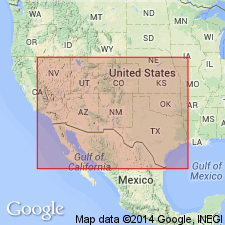
- Usage in publication:
-
- Cooper Member
- Modifications:
-
- Named
- Dominant lithology:
-
- Mudstone
- Conglomerate
- Sandstone
- AAPG geologic province:
-
- Permian basin
Summary:
Named as a member of Dockum Formation for Cooper Creek near Post (its type section) in Garza Co, TX in the Permian basin where it overlies Trujillo Member of Dockum Formation (formerly Trujillo Formation of Dockum Group), and underlies an unnamed Quaternary conglomerate. Is about 16 m thick at type; estimated to be 60 m thick at Boren's Ranch. Has been traced to Silver Falls in Crosby Co, TX to the north. Consists of mudstone in basal and middle parts, and a lime conglomerate and overlying worm-burrowed sandstone in the upper part. This nomenclature used in west TX and east NM replacing use of name Chinle Formation of Dockum Group. Chinle thought to be equivalent to the entire Dockum and not to just the upper part of the Dockum as would be implied by applying name Chinle only to rocks above Trujillo. Columnar section. Of Carnian and Norian, Late Triassic age. Has a NICROSAURUS zone fauna and may be correlative with Petrified Forest Member of Chinle in AZ.
Source: GNU records (USGS DDS-6; Denver GNULEX).
For more information, please contact Nancy Stamm, Geologic Names Committee Secretary.
Asterisk (*) indicates published by U.S. Geological Survey authors.
"No current usage" (†) implies that a name has been abandoned or has fallen into disuse. Former usage and, if known, replacement name given in parentheses ( ).
Slash (/) indicates name conflicts with nomenclatural guidelines (CSN, 1933; ACSN, 1961, 1970; NACSN, 1983, 2005, 2021). May be explained within brackets ([ ]).

